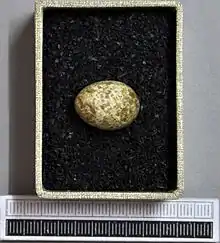African reed warbler
The African reed warbler or African marsh warbler (Acrocephalus baeticatus) is an Old World warbler in the genus Acrocephalus. It breeds in much of Africa south of the Sahara. It is migratory within the continent, with southern breeding population moving to the tropics in the southern hemisphere's winter.
| African reed warbler | |
|---|---|
_(8077249754).jpg.webp) | |
| Scientific classification | |
| Kingdom: | Animalia |
| Phylum: | Chordata |
| Class: | Aves |
| Order: | Passeriformes |
| Family: | Acrocephalidae |
| Genus: | Acrocephalus |
| Species: | A. baeticatus |
| Binomial name | |
| Acrocephalus baeticatus (Vieillot, 1817) | |
This bird is sometimes considered to be a subspecies of the Eurasian reed warbler, Acrocephalus scirpaceus.
This is a common species of marshy areas, with reeds sedges or rank vegetation. When not breeding, it may enter gardens.
Description
The African reed warbler is a plain smallish bird with a somewhat flattened forehead, 13 cm long and weighing around 11 gm. Its upperparts are rich brown, and it has a weak white supercilium. The underparts are white, with a rufous wash to the flanks. The strong pointed bill has a slightly downcurved upper mandible; it is dull yellow with a yellower base. The legs are black and the eyes are brown. The sexes are similar in appearance, but the juvenile has a rufous rump.
The song is a slow, chattering jit-jit-jit with typically acrocephaline whistles and mimicry added. It is indistinguishable from reed warbler except for the species that are mimicked.
This species can only be safely distinguished from the reed warbler in the hand. However, that species is usually found in much wetter habitats, and is rare or absent from much of southern Africa.
In southern Africa, the main confusion species is the migrant marsh warbler Acrocephalus palustris, and distinguishing these two species is not easy. Marsh warbler is larger, colder brown above, is longer-winged, and has a flatter head profile. It is also found in drier habitats and intersperses more musical phrases in its song.
Behaviour

The African reed warbler builds a deep basket nest from strips of reed blades, grass and sedges, which is lined with finer grasses and placed low in reeds. It lays two to four white eggs. This species is monogamous, pairing for life.
The African reed warbler is usually seen alone or in pairs, moving through vegetation and clambering up and down plant stems. It eats insects and other small invertebrates.
Conservation status
This common species has a large range and the population size is believed to be large. The species is not believed to approach the thresholds for the population decline criterion of the IUCN Red List (i.e. declining more than 30% in ten years or three generations). For these reasons, the species is evaluated as Least Concern.
Subspecies
Acrocephalus baeticatus includes the following subspecies:[1]
- A. b. ambiguus - (Brehm, AE, 1857)
- A. b. minor - Lynes, 1923
- A. b. cinnamomeus - Reichenow, 1908
- A. b. suahelicus - Grote, 1926
- A. b. hallae - White, CMN, 1960
- A. b. baeticatus - (Vieillot, 1817)
References
- Gill F, D Donsker & P Rasmussen (Eds). 2020. IOC World Bird List (v10.2). doi : 10.14344/IOC.ML.10.2.
- Ian Sinclair, Phil Hockey and Warwick Tarboton, SASOL Birds of Southern Africa (Struik 2002) ISBN 1-86872-721-1
External links
| Wikimedia Commons has media related to Acrocephalus baeticatus. |
| Wikispecies has information related to Acrocephalus baeticatus. |
- African marsh/reed warbler - Species text in The Atlas of Southern African Birds.

